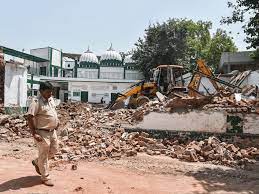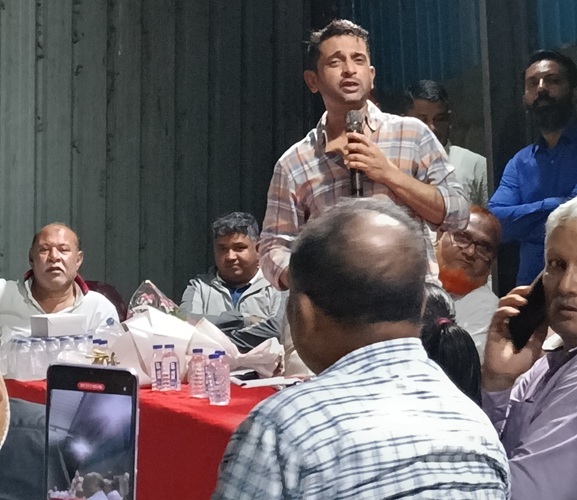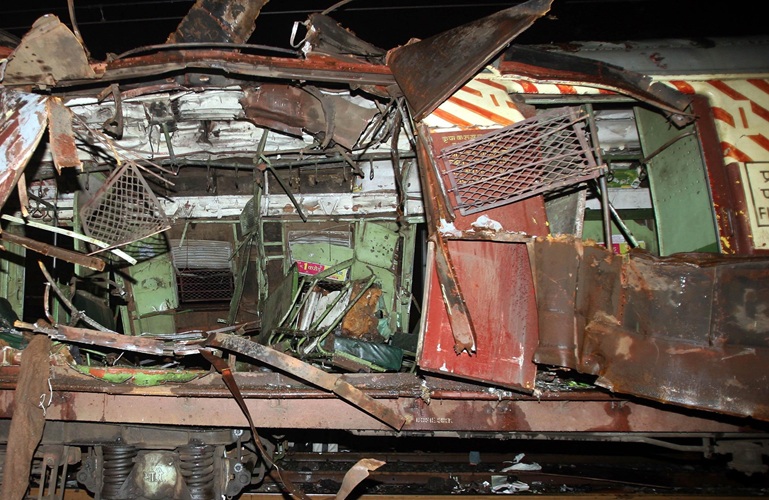Maeeshat News Network | Mumbai
In recent years, the term “bulldozer justice” has emerged as a contentious phrase in India’s socio-political landscape, particularly in states like Uttar Pradesh. This phenomenon refers to the use of bulldozers to demolish properties of individuals accused of crimes, often without due process, as a form of swift, extrajudicial punishment. Championed by political figures like Uttar Pradesh Chief Minister Yogi Adityanath, bulldozer justice has been portrayed by some as a symbol of decisive law enforcement.
However, it has drawn sharp criticism for violating fundamental rights and disproportionately targeting marginalized communities, particularly Muslims. The Indian judiciary, led by the Supreme Court, has responded with significant interventions to curb this practice, reinforcing the rule of law.
The Rise of Bulldozer Culture
The term “bulldozer justice” gained prominence in 2017 when Yogi Adityanath, upon assuming office as Chief Minister of Uttar Pradesh, vowed to tackle crime aggressively. His administration established an anti-mafia task force, with statements like “Leave UP or go to jail” signalling a hardline approach. By September 2017, Adityanath explicitly warned that properties of those involved in crimes, particularly against women and weaker sections, would be bulldozed. This rhetoric transformed the bulldozer from a tool for clearing illegal constructions into a political symbol of “instant justice,” particularly in Bharatiya Janata Party (BJP)-governed states.
The practice escalated in incidents like the 2022 Jahangirpuri demolitions in Delhi, where, following communal violence, local authorities deployed bulldozers to raze structures, including those of registered buildings, within days of the clashes. Similar actions occurred in Nuh, Haryana, and Khargone, Madhya Pradesh, where homes and businesses, often owned by Muslims, were demolished under the pretext of addressing encroachments or unauthorized constructions. According to the Housing and Land Rights Network, authorities demolished 153,820 homes in 2022 and 2023, displacing over 738,438 individuals, with a disproportionate impact on minority communities.
Critics, including opposition leaders like Akhilesh Yadav and Manish Sisodia, have labelled bulldozer justice as a tool of extortion and communal targeting, accusing the BJP of using it to vilify Muslims and consolidate political support among Hindu nationalists. The bulldozer has even been celebrated by some as a symbol of law enforcement, with nicknames like “Bulldozernath” and media spectacles, such as a journalist climbing onto a bulldozer during a demolition in Jahangirpuri. However, these actions have raised alarms about state-sanctioned impunity and the erosion of due process.
The Human Cost of Bulldozer Justice
Bulldozer justice has profound human and legal consequences. Demolitions often occur without adequate notice, leaving families homeless and without recourse. In Jahangirpuri, residents reported that even legally registered structures were damaged, and street carts were destroyed, impacting livelihoods. The timing of demolitions, often following communal violence, has fueled suspicions of retributive intent. For instance, in Khargone, homes of alleged rioters were demolished, raising questions about selective targeting based on religious identity.
The practice undermines the fundamental right to shelter, protected under Article 21 of the Indian Constitution, which guarantees the right to life and personal liberty. It also bypasses the principle of due process, as properties are demolished based on accusations rather than convictions. As Justice B.R. Gavai poignantly stated, “How can anybody’s house be demolished only because he is an accused? Even if he is a convict, it cannot be done without following the procedure as prescribed by law.” This reflects the judiciary’s concern that bulldozer justice conflates the roles of judge and executioner, violating the separation of powers.
Moreover, the social impact is staggering. The displacement of over 738,000 people in two years has exacerbated poverty and marginalization, particularly among already vulnerable communities. Critics argue that bulldozer justice perpetuates a cycle of injustice, as Martin Luther King Jr.’s words resonate: “Injustice anywhere is a threat to justice everywhere.” The selective nature of demolitions, often sparing similar unauthorized structures in non-targeted communities, suggests mala fide intent, as noted by the Supreme Court.
The Supreme Court’s Intervention
The Indian judiciary, particularly the Supreme Court, has played a pivotal role in addressing bulldozer justice. In 2024, the Court, led by Justices B.R. Gavai and K.V. Viswanathan, issued landmark guidelines to curb illegal demolitions, declaring them “simply unacceptable under the rule of law.” The Court’s interventions began with interim orders, such as the one halting demolitions in Jahangirpuri in 2022, though compliance was initially uneven, with demolitions continuing for an hour after the order.
On November 13, 2024, the Supreme Court issued comprehensive guidelines to ensure due process. These include mandating a 15-day notice period before demolition, requiring authorities to specify reasons for the action, and mandating that the process be filmed to ensure transparency. Violators face contempt of court charges, personal liability for restitution, and compensation for affected parties. The Court clarified that these guidelines do not apply to unauthorized constructions on public lands, such as roads or water bodies, or to court-ordered demolitions, striking a balance between law enforcement and rights protection.
The Court’s rulings draw on its powers under Article 142 of the Constitution, which allows it to pass orders necessary for “complete justice.” This provision, combined with Article 32 (right to constitutional remedies), empowers the judiciary to safeguard fundamental rights. The guidelines aim to foster institutional accountability, with legal experts like Alok Prasanna Kumar noting that holding officials personally liable will deter arbitrary demolitions. However, scepticism persists, given the limited success of past judicial guidelines on issues like hate speech.
The Broader Implications
The Supreme Court’s intervention is a significant step toward upholding the rule of law, but it does not fully address the socio-political roots of bulldozer culture. The practice reflects a broader trend of populist governance, where symbolic actions like demolitions are used to project strength and appeal to certain voter bases. The judiciary’s role, while crucial, is limited to legal remedies and cannot directly tackle the political motivations behind such actions.
Moreover, bulldozer justice raises questions about the balance between law enforcement and human rights. While unauthorized constructions must be addressed, the selective and punitive nature of demolitions undermines public trust in governance. The judiciary’s insistence on due process is a reminder that justice cannot be sacrificed for expediency. As the Court noted, “The executive cannot become a judge and demolish properties. The chilling sight of a bulldozer demolishing a building reminds one of lawlessness where might was right.”
Bulldozer justice represents a troubling convergence of political symbolism and extrajudicial punishment, challenging India’s constitutional framework. The Supreme Court’s guidelines are a critical intervention, reinforcing the principles of due process and accountability. However, the persistence of such practices underscores the need for broader societal and political reforms to address communal biases and executive overreach. As India navigates this complex issue, the judiciary’s role as a guardian of fundamental rights remains paramount. By condemning bulldozer justice, the Supreme Court has reaffirmed that true justice lies not in the might of machinery but in the strength of the rule of law.






0 Comments